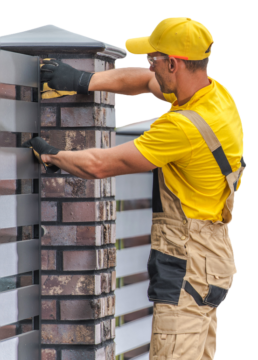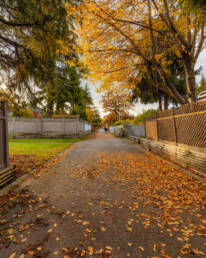Fences need to be cared for properly to help prevent any fence related issues that may cause a fence to lean, sag or fall down. Use these 5 simple tips to help ensure that your fence remains intact and in good condition.
1. Install a Fence Correctly & Perform Regular Fence Inspections
One of the most important tips to heed is to install a fence correctly. Afterwards, your fence should be inspected following storms, with heavy wind gusts, or other weather or environmental situations like flooding, mudslides and other property damaging events.
Installing a fence can be challenging for DIY enthusiasts without extensive experience and the proper tools to do the work right the first time. If unsure about doing the job by yourself, it may be a good idea to have a local fencing contractor perform the work for you.
Most fencing problems involve improper placement of fence posts that could then be dislodged after heavy rainfall that can shift the soil surrounding the post causing it to lean and eventually to fall if not repaired promptly.
2. Spot & Repair Any Fence Weak Areas
Over time, a fence can develop weak areas that could result in further fence damage. Take time to complete a thorough inspection to increase chances of spotting a weak area or other fence damage before it causes more damage that can be pricy to fix or repair.
Sometimes, all that is needed is to firm up post in the ground being sure to anchor each post and pour concrete around it. If there are any loose fencing materials, these may be reattached effectively tightening the loosened pieces to keep the fence from leaning and falling over as a direct result.
3. Check for Post Rot Then Fix or Replace the Affected Post
Wooden fences often develop post rot that can be difficult to spot without doing a careful inspection along the entire fence perimeter. The posts often develop rot in the interior layers, so when the post rot is finally discovered, it is usually a more serious situation.
If the ground that surrounds the affected post is soggy or has extensive debris that is pushing on the post, you may be able to fix the ground and soil issues by ensuring that those areas have proper drainage. This is done for routing accumulated water away from the fence following a heavy downpour or after snow and ice on the fence begins to melt.
After fixing that problem, carefully sand or drill away any evident signs of rot and fix or replace the involved post.
4. Watch for Leaning Fence Areas or a Sagging Gate & Resolve Causative Issues
Oftentimes, a portion of a fence will first begin to lean, or a gate may start to sag. Nearby trees and bushes can put pressure on a fence portion resulting in the fencing material in that region to begin to lean towards one side or the other and eventually falling due to gravity and other forces.
Any time that you find a leaning fence, it is crucial to address the problem and resolve any potential causative issues swiftly to lessen the damage extent and repair costs along with saving on effort. Trim back any tree limbs or bushes near the fence issues. Take steps to fix the issue quickly. You might need to reattach certain fencing materials and repair whatever problem is causing the gate to sag.
5. Reattach Rails to Repaired Posts, Reattach Pickets & Do Regular Maintenance
After ensuring that leaning posts are repaired properly, you can then reattach rails to the now secured and stabilized posts. If pickets or other fence elements had to be unattached or were found to be in this state, try reattaching the items.
It is essential that property owners take the time and small effort to evaluate their fences regularly and following any significant weather or other natural disaster situation as soon as it is deemed safe to do so.
Wooden and some metal fences will need to be repainted or refinished at regular intervals recommended by the manufacturer or when the surfaces of the fencing materials are obviously damaged. Also, complete maintenance tasks when the finish is worn, rusted or appears corroded.
Section 2:
A newly installed fence of any sort will need ongoing maintenance to help limit any damage that may occur as a result from environmental and weather-related factors, age, rust, or other corrosion, stain development and pressure damage that might happen if heavy tree limbs, bushes or other larger objects are situated close to the fence causing it to bend and lean due to the pressure force.
There are some important steps that property owners can do to lessen any damage to a fence through the years.
Fences Have Many Fantastic & Practical Advantages When Kept in Good Repair
Keeping your property line edges neat and tidy also helps to make the outdoor landscape of a home look well cared for and attractive. Fences also serve a practical purpose in providing privacy and protection inside the perimeter of the fence that may be placed around a property, surrounding a pool or patio or for keeping young children and pets safe when playing outdoors.
Conclusion:
Heed these 5 easy and practical tips so your fence doesn’t fall when fall rolls around this year. Fences can be highly beneficial in creating a pleasing outdoor appearance that passerby traffic can admire which is often termed as increased curbside appeal.
Get friendly and knowledgeable assistance and answers to your questions regarding fences by contacting Denco Fence Company by phone via (303) 223-6902 or online at Inquiries@dencofence.com. Begin the process for determining an approximate estimate for fence related services by accessing https://dencofence.com/estimates anytime at your convenience.

Need an expert opinion? Talk to our experts today!
When you talk to our experts at Denco Fence Company, we’ll help you compare fence styles, share design ideas, and answer any questions along the way. If you’re looking to build or repair a fence that you and your neighbors are going to love, get a free estimate and let us help bring your project to life.

